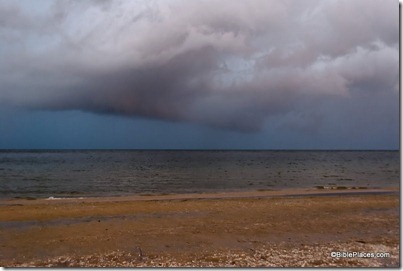Traveling around Galilee last month, it felt like there was just no dodging the rain. It turns out that that was more than a feeling, for the Israel Meteorological Service is reporting that rain fell on 29 out of 31 days in January. From Haaretz:
Measuring stations in Nahariyya and the Galilee registered a new record in the number of rainy days in a row, with rain falling for 27 days in a row, from January 5 to 31. The former record was held by the Druze village of Yarka, where rain fell for 23 days in a row in February and March 1987. According to Dr Amos Porat of the Meteorological Service, there was 250-250 milimeters of rainfall in the north of Israel, 1.5 to 2 times greater than the multi-year average for rainfall in January.
The Jerusalem Post reports that the Sea of Galilee rose 1.5 feet (50 cm) but is still more than 4 inches (11 cm) below the red line. February, however, is a critical month if the seven-year drought is to be ended.
“After the seven drought years we’ve had, the lack of water is so huge that we need much, much, much more to cover even part of that,” Schor said. “We are happy with January, but we can’t be satisfied from it.” It is not possible to determine whether this will also be considered a drought year until the end of the rainy season. However, two-thirds of winter has already elapsed, and 4.31 meters is still missing from the Kinneret’s basin, according to Schor. The average winter Kinneret rise is about 1.6 meters, and thus far, the 2011-2012 winter season has seen only a rise of centimeters. “It’s not a good situation,” Schor said.
The Post also provides rainfall statistics for various sites in the north.
Among areas monitored by the IMS, the highest level of January rain in Israel fell in Rosh Hanikra (316 millimeters, 218% of the area’s average), Eilon (389 millimeters, 194% of average), Mitzpe Harashim (406 millimeters [16 inches], 171% of average), Merom Golan (321 millimeters, 160% of average) and Kfar Giladi (320 millimeters, 156% of average). Jerusalem received 100% of its typical rain, at 124 millimeters, according to the IMS.
Neither of the articles mentions the source of the rain.
Jeremiah 14:22 (NIV) “Do any of the worthless idols of the nations bring rain? Do the skies themselves send down showers? No, it is you, O Lord our God. Therefore our hope is in you, for you are the one who does all this.”

One thought on “Record Rainfall in Galilee in January”
Comment by Tom Powers:
Todd, hi — Thanks for posting this. It may help people to understand that there are TWO "red lines" for the Kinneret, measured in meters BELOW sea level, which is where the lake is situated:
The upper red line is minus 208.8 m; this is where the lake is full and water either has to be released down the Lower Jordan River channel at the Deganya dam (Yardenit) OR extra water must be pumped out — into the ground! — to replenish the aquifers. When the situation arises, which is rarely, the Israelis have opted for the latter.
Under discussion in this article is the LOWER red line, at minus 213 m. It is the level at which the lake is so low it is at risk of ecological damage due to concentrated pollutants, etc. Therefore, it's the point below which the lake is not "supposed" to be pumped at all. However, the Israelis have had to routinely ignore this, as they currently have no other recourse, until other water sources are developed or consumption is curtailed — the Kinneret represents 1/3 of the national water supply! So, the lake is just now in early February, well into the rainy season, filling to this LOWER red line — that's how critical things are, really on an ongoing basis.
(Haaretz ran a dreadfully inaccurate story a few weeks ago stating that the level was hovering below the UPPER red line — but it was the LOWER of course. Anyone can get confused, I guess.)
And, yes, there is also a BLACK line, at -214.87, a pretty dire situation where the pump intakes are actually exposed. But, we've been there in recent years.
If people like tracking such things, here's an official Israeli web-page that shows the current lake level. It's in Hebrew, but see the graphic box with the bobbing yellow duckie and the numbers! Click on the box for another page with more data: http://www.water.gov.il/hebrew/Pages/home.aspx
TOM POWERS / Jerusalem